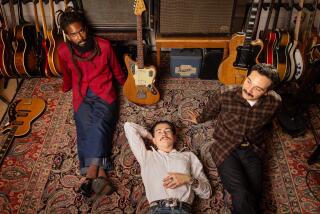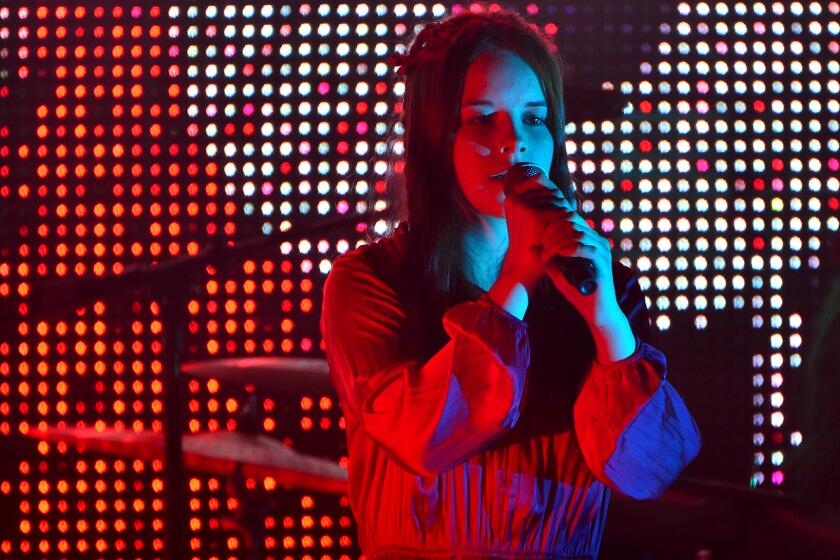Social Conscience Is Alive, Well : Music: It appears the Indigo Girls have come up with another hit album. But watching the audience mouth words to their songs provides the most satisfaction.
SAN DIEGO — The runaway success of the Indigo Girls’ eponymous major-label debut album, which went gold seven months after its February, 1989, release and won the folk duo a Grammy, wasn’t a fluke.
Their follow-up, “Nomads*Indians*Saints,” came out six weeks ago and began a similar climb up the charts. On Billboard’s Top Pop Albums chart, it’s currently number 42 with a bullet, indicating particularly significant sales gains.
Indigo Girl Amy Ray, 26, doesn’t measure success by statistics, however--just the reaction she and 27-year-old Emily Saliers get from crowds on the concert trail, which brings them to San Diego on Sunday night for a show at Symphony Hall downtown.
“Just like last time, what really gets us going is when we play somewhere and people know all the words to our songs,” Ray said. “Radio play is important, but we don’t pay too much attention to it; we don’t place much emphasis on the charts and stuff, because it would kind of make you crazy if you do that.
“Instead, we just relate to our audience, and how our audience reacts to us.”
That the audience reacts to the Indigo Girls at all is something of a surprise. Talk about an unlikely success story: Two gals plucking away on their acoustic guitars, singing songs about social responsibility and getting your act together, more than a quarter century after the heyday of the early 1960s Greenwich Village folk scene, when this sort of stuff was in vogue.
“We never really expected anything,” Ray said, “so we’re happy with the way things are going--but we never thought about whether we were going to be successful, so it’s not a surprise, but it’s not not a surprise,either.”
This nonchalant attitude toward success is in sharp contrast to the Indigo Girls’ attitude toward life and what to do with it, as expressed in their music. Their new album is full of rules to live by (“Gotta tend the earth if you want a rose,” from “Hammer and a Nail”) and social observations (“The evil ego and the vice of pride/Is there ever anything else that makes us take our different sides,” from “You and Me of the 10,000 Ways”).
“We were both raised Methodists, and it’s kind of that Judeo-Christian viewpoint of charity that got into our bones,” Ray said. “My parents taught me a certain amount of social responsibility, things like you give back what you take out of the world, you treat others as you want to be treated.
“Those basic golden rules were really drilled into our heads, and they stuck with us. Sometimes I think you’re given a gift and you’re expected to use it in a responsible way, and you don’t know why, or where it came from, you just feel driven in a certain way, and that’s kind of how we feel.”
The socially conscious tint to the Indigo Girls’ tunes may be a product of their upbringing, but it’s also due, in part, to their early musical influences. Ray said she grew up listening to the Jefferson Airplane, Neil Young and early Elton John; Saliers was a big fan of Joni Mitchell.
The two met in sixth grade in Decatur, Ga., a suburb of Atlanta, and began singing together while in high school.
“We were about 16, 17, and there was this place in Atlanta called Good Old Days,” Ray recalled. “We started out singing on open-mike night, and then they started letting us play professionally if we agreed not to drink and stuff, because we were still underage.”
Their repertoire consisted mostly of covers of songs by the likes of James Taylor, Dan Fogelberg and Elton John, Ray said. “We’d pick out the more obscure songs, and we were always attracted to songs with messages, or lessons, in them.”
After high school, Ray and Saliers went off to separate colleges and put their nightclub act on hold. During their brief hiatus, they polished up their songwriting. In 1984, they were once again at the same school, Emory University in Atlanta, and once again singing together in nightclubs.
“That’s when we really decided to get serious and play a lot of original music,” Ray recalled. “We took out a loan in 1985 and put out a single; a year later, we took out another loan and put out an EP (extended play record), and in 1987, we took out a third loan and put out an album.
“For the album, ‘Strange Fire’ (which was reissued by Epic, their current label, last November), we did a lot of radio promotion on the college circuit. We got national distribution through Important Records and tracked the record so that we’d play wherever it got a particularly good response, up and down the East Coast.
“It ended up selling about 7,500 copies, which is pretty decent for an independent release.”
Tom Simonson, a college rep for Epic Records, was given a copy of “Strange Fire” by a college-radio deejay and passed it on to Roger Klein, one of Epic’s A&R; (artists & repertoire) men.
“Roger listened to it, liked it, saw us live, and offered us a record deal,” Ray said. “And we took it because they were willing to give us what we wanted without compromising, and we thought we’d be happy with that, and we were.”
In 1988, the Indigo Girls entered a Los Angeles recording studio to cut their debut Epic album. Lending a hand in the studio were a handful of celebrated guest artists, including R.E.M.’s Michael Stipe, whom they had met the year before in an Atlanta nightclub.
The album came out in February, 1989, and immediately got a slew of great reviews. The Indigo Girls subsequently hit the road on a major U.S. tour, headlining their own shows and opening for R.E.M. and Neil Young. The album was certified gold in September and last February won the Indigo Girls a Grammy for Best Contemporary Folk Group of 1989.
Ray and Saliers have spent most of this year in the studio working on their new album and on the road touring on their own and with Joan Baez.
And now that the new album is out and doing quite well, Ray said, she and Saliers are planning to take a little time off from songwriting before they even start to think about album number three.
“We’re still trying to get our feet on the ground with this one,” she said.
More to Read
The biggest entertainment stories
Get our big stories about Hollywood, film, television, music, arts, culture and more right in your inbox as soon as they publish.
You may occasionally receive promotional content from the Los Angeles Times.










